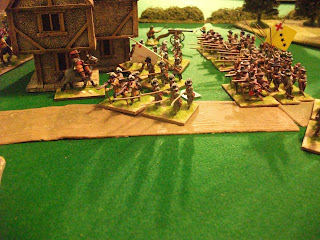 |
| A view of the table from behind the Royalist force. |
Steve commanded the defenders and these were activated by die roll.
My plan was to send the cavalry forward over Barren Fell towards Long Furlough, identifying any enemy forces in the area. Bradshaw was to clear the enclosure and then take Locke Farm with the commanded shot and Widdop's dragoons, leaving Harrington's foot free to advance towards Long Furlough. All began well. Widdop's rode up to the enclosure and found it unoccupied and the commanded shot then moved up to the track junction near Locke Farm. Bracewell's unit of horse galloped up onto Barren Fell, found it unoccupied and then set off at speed towards Long Furlough. Unfortunately, Catlow's and Ashton's horse seemed reluctant to follow them and it took a personal intervention from Sir Edward to get them moving forward. Harrington's were also reluctant to move forward and Colonel Bradshaw had to come back to almost shame them into advancing.
The first enemy resistance was met at Locke Farm. Sir Nicholas Starkie, the local Parliamentary commander, had billeted a unit of dragoons at the farm and they had had a 'convivial' evening, having liberated the farmer's stock of ale. They were rudely awakened by a volley from the commanded shot. Bradshaw had instructed the commanded shot to fire volleys at the farm, but the lack of reply and Bradshaw's absence, encouraged the commander of the commanded shot to order a rapid advance toward the farm. As they tried to enter the farm buildings they were met by the determined resistance of the Parliamentary dragoons, who had had just enough time to organise a defence. A fierce melee ensued in which the commanded shot came off worst and they had to fall back to rally and recover.
 |
| The commanded shot approach Locke Farm |
 |
| And are repelled |
On Locke Down, De Lisle saw that Bracewell's were well placed to attack the commanded shot and ordered a charge. The commanded shot managed to fire a volley, but the horse still charged home and almost broke through. The gallant infantry fought like tigers and against the odds drove off the cavalry with heavy losses.
 |
| Bracewell's are driven off by the commanded shot |
The removal of half the Parliamentary cavalry gave Sir Edward a chance to attack the village. Harrington's regiment fired a volley at Ireby's regiment which decimated their ranks. He followed this up with a charge. As the Royalist's swept forward they came under fire from the gun to their right and the commanded shot to their left. Undeterred they closed with Ireby's, which broke and routed. Catlow's regiment of horse charged the Parliamentary commanded shot and swept them from the field.
 |
| Ireby's rout |
 |
| Catlow's rout the commanded shot |
After a few teething troubles with the technology this first 'skype' game worked very well. Communication between Steve and I was straightforward and the picture quality enabled a good view of the battlefield. The fixed view meant that it was perhaps a more realistic representation of what a commander on the spot could have seen, rather than the 'all seeing eye' of the gamer who can walk around the table. We both enjoyed the experience and although it lacked the full level of interaction of our usual games it is far better that no game at all. With the 'lock-down' due to continue in all likelihood for a few weeks yet at least there could be more games of this type.
No comments:
Post a Comment